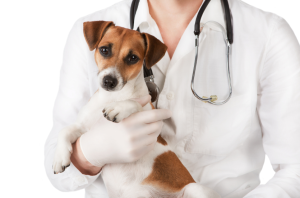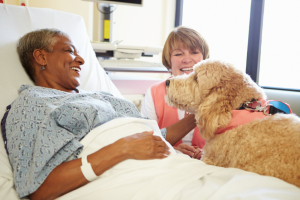 What would you do if your dog was constantly sniffing or even trying to bite a mole off of your leg? Today, you might take it seriously and run to the doctor’s office, but 20 years ago, who could have imagined that dogs were capable of picking up their owners developing cancer or imminent seizure or hypoglycemic episode? In the past 20 years, we’ve seen a growing number of anecdotal reports of dogs helping with all sorts of medical conditions. How can they do it? Although our dogs love us, it’s not because of their sixth sense or assumed psychic powers. The secret is in their phenomenal sense of smell. Diseases such as cancer have what’s called a ‘signature scent’, a specific combination of volatile organic compounds (VOCs) that are released in a person’s breath, urine or tissues. Diabetic patients as well as epileptic patients also seem to express specific VOCs before and during the seizure of hypoglycemia episode. A new study uncovers yet another application of our dog’s nose: identifying patients with a clostridium difficile infection (CDI).
What would you do if your dog was constantly sniffing or even trying to bite a mole off of your leg? Today, you might take it seriously and run to the doctor’s office, but 20 years ago, who could have imagined that dogs were capable of picking up their owners developing cancer or imminent seizure or hypoglycemic episode? In the past 20 years, we’ve seen a growing number of anecdotal reports of dogs helping with all sorts of medical conditions. How can they do it? Although our dogs love us, it’s not because of their sixth sense or assumed psychic powers. The secret is in their phenomenal sense of smell. Diseases such as cancer have what’s called a ‘signature scent’, a specific combination of volatile organic compounds (VOCs) that are released in a person’s breath, urine or tissues. Diabetic patients as well as epileptic patients also seem to express specific VOCs before and during the seizure of hypoglycemia episode. A new study uncovers yet another application of our dog’s nose: identifying patients with a clostridium difficile infection (CDI).
It’s likely that some dogs have reacted to changes in their human’s physical conditions all along, but we just weren’t paying attention! We can also assume that from an evolutionary standpoint, it makes sense to be sensitive to signs of distress or medical weakness in another animal. As carnivores, this ability would give them a real advantage over prey. When a dog is deeply bonded to a person, sensing signs of physical distress could lead to visible signs of anxiety in some dogs. Reports of pets displaying very unusual behaviors prior to a seizure or to a drop in glucose levels or showing a persistent interest to a particular area of their guardian’s body captured the interest of the medical community. If some dogs are capable of sensing that something is wrong, why not develop that ability to effectively train more dogs to help with such medical conditions?
 But what do the dogs detect? It was assumed that subtle changes in the person’s behavior could lead to the dog’s reaction, but increasing evidence today points to the ability of the dogs to smell the changes in the human body. After all, dogs can smell certain scents at one part per trillion (Pearsall and Verbuggen, 1982), which is so far out of our reach, that its impossible for us to even imagine what it would be like to have such sensitivity. At least in search and rescue, narcotics or bomb detection training, we can control the presence or absence of the cue. In medical detection, the most critical problem so far has been to identify and control what the dogs were picking up. In the early 70s, technology allowed scientists to identify chemical compounds present in our breath (Pauling & al., 1971). The fact that certain biological markers are specific to different medical conditions, confirms the possibility that dogs could identify changes in our bodily chemistry.
But what do the dogs detect? It was assumed that subtle changes in the person’s behavior could lead to the dog’s reaction, but increasing evidence today points to the ability of the dogs to smell the changes in the human body. After all, dogs can smell certain scents at one part per trillion (Pearsall and Verbuggen, 1982), which is so far out of our reach, that its impossible for us to even imagine what it would be like to have such sensitivity. At least in search and rescue, narcotics or bomb detection training, we can control the presence or absence of the cue. In medical detection, the most critical problem so far has been to identify and control what the dogs were picking up. In the early 70s, technology allowed scientists to identify chemical compounds present in our breath (Pauling & al., 1971). The fact that certain biological markers are specific to different medical conditions, confirms the possibility that dogs could identify changes in our bodily chemistry.
In the past decade, there have been a number of studies revealing the ability of trained dogs to identify melanoma, ovarian, prostate, colorectal or lung cancer (Pickel & al., 2004; Horvath & al., 2008; Cornu & al., 2011; Sonoda & al., 2011; Ehman & al., 2012). Studies on the ability of dogs to detect changes in glucose levels are still in their infancy. Most evidence at this point is anecdotal although dogs have been trained for about a decade to alert their person to a change in their blood glucose level. Patients suffering from type 1 diabetes become desensitized over time, and no longer feel physical symptoms of drops in their glucose levels, until they are dangerously low. A preliminary study has shown the ability of dogs to discriminate between samples collected during a hypoglycemic episode and samples collected at normal glucose levels or blanks, thus confirming that there is indeed a particular smell associated to the glycemic episode (Hardin & al., 2013). Empirical evidence has also shown that dogs can reliably be trained to detect the onset of seizures. At this point however, their reliance on physiological changes has not yet been successfully tested. In all these cases however, whether in cancer detection, diabetes alert or seizure alert, there is much need for more research in the field and most importantly for standardized training procedures. With little understanding of the chemical compounds at play, there are many inconsistencies in the training of such dogs, leading to all sorts of variations in the results.
 If dogs can detect changes in our physiology, couldn’t we use them for even more medical conditions? In a new study, dogs were trained to identify patients affected with C. difficile (CDI). Each year, over half a million people are infected with CDI. Recently, such infections have been more frequent, more severe and more difficult to treat. CDI has typically affected mostly older patients in hospitals or long-term care facilities after an antibiotic treatment. Nowadays however, this bacteria affects even younger and healthier patients that have not been exposed to antibiotics or been hospitalized. CDI will cause inflammation in the colon and may experience severe diarrhea and all the complications that can come with it (dehydration, fever, loss of appetite, weight loss, kidney failure, etc.). This bacteria is present in the environment and can produce spores that will survive and when they don’t wash their hands, will spread the bacteria by touching different surfaces and objects. The healthy bacteria in our intestines will protect our body from an infection, but when we take antibiotics, these bacteria may be destroyed, giving room for CDI to quickly take over. Since 2000, a new strain of this bacteria has emerged and has proven much more aggressive than ever.
If dogs can detect changes in our physiology, couldn’t we use them for even more medical conditions? In a new study, dogs were trained to identify patients affected with C. difficile (CDI). Each year, over half a million people are infected with CDI. Recently, such infections have been more frequent, more severe and more difficult to treat. CDI has typically affected mostly older patients in hospitals or long-term care facilities after an antibiotic treatment. Nowadays however, this bacteria affects even younger and healthier patients that have not been exposed to antibiotics or been hospitalized. CDI will cause inflammation in the colon and may experience severe diarrhea and all the complications that can come with it (dehydration, fever, loss of appetite, weight loss, kidney failure, etc.). This bacteria is present in the environment and can produce spores that will survive and when they don’t wash their hands, will spread the bacteria by touching different surfaces and objects. The healthy bacteria in our intestines will protect our body from an infection, but when we take antibiotics, these bacteria may be destroyed, giving room for CDI to quickly take over. Since 2000, a new strain of this bacteria has emerged and has proven much more aggressive than ever.
Here again, dogs can make a difference. During 9 different hospital visits, specially trained dogs successfully identified 12 out of 14 cases among 371 participants. Dogs have shown to be extremely accurate in the identification of CDI (sensitivity of 86%; specificity 97%) and can help in a quicker diagnosis, thus limiting the spread of this problematic infection (Borners, 2014).
So far dogs have shown their ability to contribute their exceptional sniffer to just a handful of medical conditions. With growing evidence of their capacity to identify specific VOCs, we can only imagine how many more diseases they could help diagnose in the early stages. Maybe one day, dogs will become a familiar sight in every hospital, clinics, doctor’s offices, as non-invasive, precise, stress reducing and friendly medical assistants.
Jennifer Cattet Ph.D.


Can dogs predict a migraines? http://www.psychologytoday.com/blog/animals-and-us/201406/can-dogs-warn-their-owners-impending-migraines
Can dogs detect high ammonia levels